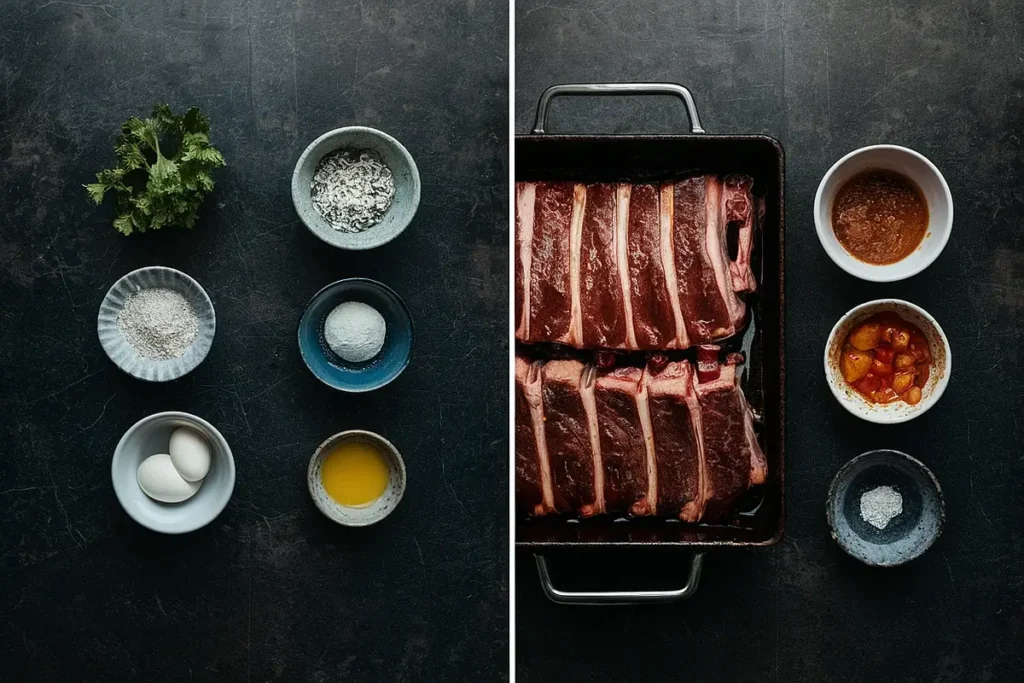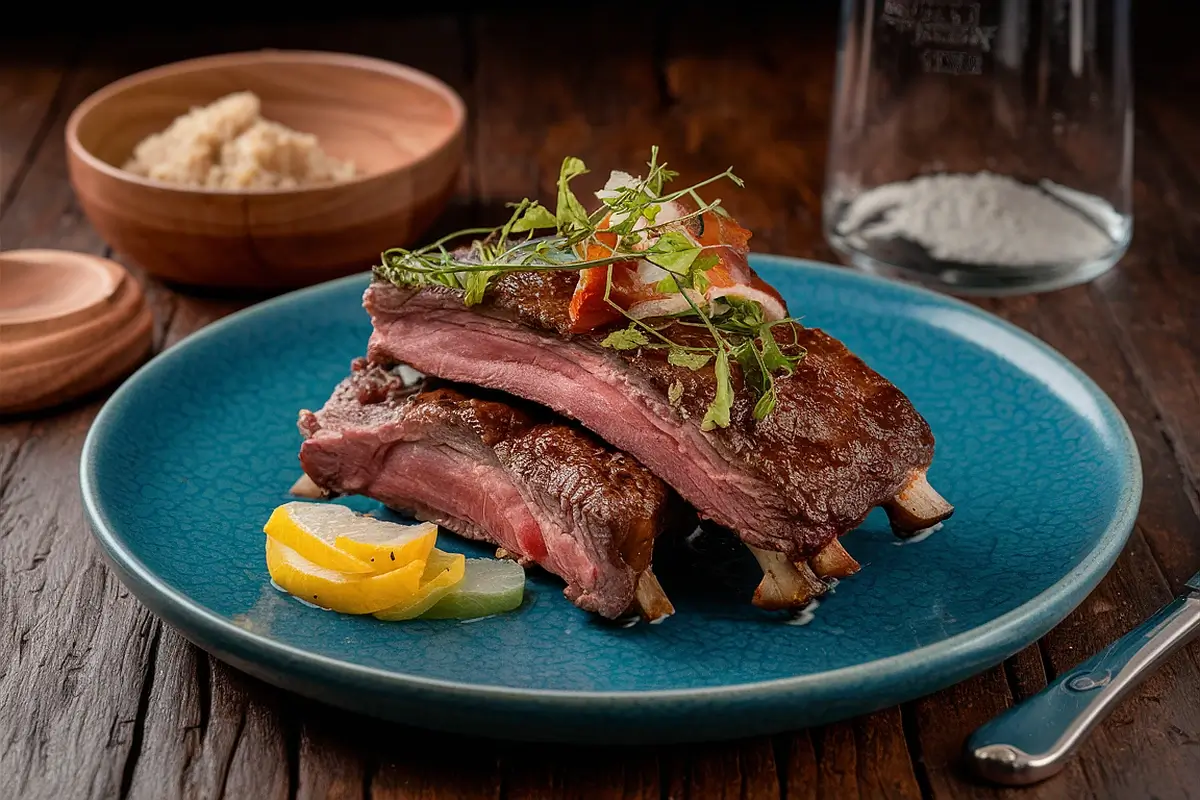Cooking beef back ribs in the oven is an easy and delicious way to enjoy tender, flavorful ribs without needing a grill. If you’re wondering how to cook beef back ribs in the oven, this guide will take you through every step to achieve perfect results. From selecting the best ribs to slow-cooking them to perfection, you’ll soon master this simple oven-baked method.
What are Beef Back Ribs?
Before diving into the cooking process, it’s important to understand what beef back ribs are. These ribs come from the upper part of the cow’s ribcage, specifically from the same area as prime rib. Compared to short ribs, beef back ribs have more bone and less meat, but the meat is incredibly tender when cooked properly.
- Beef back ribs vs. short ribs: Short ribs are meatier but tougher, while back ribs are leaner and more tender when slow-cooked.
- Texture and flavor: Expect rich, beefy flavor with a juicy, fall-off-the-bone texture when cooked right.
Why Cook Beef Back Ribs in the Oven?
There are several ways to cook beef ribs, but oven-baking is one of the easiest and most effective methods. The slow, even heat of the oven allows the ribs to cook gently, breaking down the tough connective tissue without drying out the meat.
- Low-and-slow cooking: The key to tender ribs is cooking them at a low temperature over a long period.
- Why choose the oven? The oven offers better control of temperature and timing compared to grilling or smoking. Plus, it’s a more convenient option, especially for those without a grill. You can read more about the differences between beef ribs here.
Choosing the Best Beef Back Ribs
When selecting ribs for your oven-baked dish, there are a few factors to keep in mind. Choosing the right cut ensures maximum flavor and tenderness.
- Look for marbling: The more marbling (fat within the meat), the juicier and more flavorful your ribs will be.
- Bone size: Larger bones typically mean more tender meat, as the fat and connective tissue surrounding them cook down slowly.
- Fresh vs. frozen: Fresh ribs will always give a better texture, but frozen ribs can still deliver great results if thawed properly.
Prepping the Beef Back Ribs
Once you have your beef back ribs, preparation is key to ensuring they cook perfectly in the oven.
Trimming the Ribs
Most store-bought beef ribs will have a layer of fat and silver skin (a tough membrane) that needs to be trimmed. Here’s how to prepare them:
- Use a sharp knife to carefully remove any excess fat.
- Pull off the silver skin from the bone side of the ribs—it’s tough and won’t break down during cooking.
To Marinate or Not to Marinate?
While marinating is optional, it can add extra flavor and tenderness to your ribs. You can use either a marinade or a dry rub.
- Marinades: Acidic ingredients like vinegar, lemon juice, or soy sauce help tenderize the meat. Let the ribs sit in the marinade for at least 4 hours (or overnight) in the fridge.
- Dry rubs: A blend of salt, pepper, garlic powder, paprika, and a touch of brown sugar makes a perfect seasoning for ribs. Apply it generously and let it sit for an hour before cooking.
How Long to Cook Beef Back Ribs in the Oven?
Now that your ribs are prepped, it’s time to cook them! Cooking beef back ribs in the oven requires patience, but the results are worth the wait.
Time and Temperature Guide
- Low-and-slow method: For the best results, cook your ribs at 275°F (135°C) for about 3 to 4 hours.
- Testing for doneness: Ribs are done when the internal temperature reaches 200°F (93°C). You can also check by pulling on the bones—if they start to easily separate from the meat, the ribs are ready.
Lower temperatures ensure that the ribs stay moist and develop a tender texture, while higher temperatures may cause the meat to dry out.
Step-by-Step Guide to Cooking Beef Back Ribs in the Oven

Here’s a breakdown of how to cook your ribs from start to finish:
- Preheat the oven: Set your oven to 275°F (135°C).
- Prepare a baking sheet: Line it with foil or parchment paper for easy cleanup.
- Season the ribs: Apply your marinade or dry rub evenly across the ribs.
- Wrap in foil: For ultra-tender ribs, wrap them in foil—this technique, often referred to as the “Texas Crutch,” helps retain moisture during cooking.
- Bake low and slow: Place the ribs on the prepared baking sheet and bake for 3 to 4 hours.
- Unwrap for browning: During the last 30 minutes of cooking, unwrap the ribs and let them brown for a delicious caramelized crust. You can also baste with BBQ sauce at this stage.
- Rest the ribs: Let the ribs rest for about 10 minutes before slicing to allow the juices to redistribute.
Tips for Perfect Beef Back Ribs in the Oven
If you want to take your beef back ribs to the next level, here are a few tips to keep in mind:
- Basting with sauce: Apply your favorite BBQ sauce during the last 30 minutes of cooking for a sweet, sticky finish.
- Caramelized crust: If you prefer a crispy exterior, you can broil the ribs for 3-5 minutes at the end of cooking.
- Smoky flavor: For a hint of smoke without using a grill, add a few drops of liquid smoke or use smoked paprika in your rub.
Troubleshooting is also key: if your ribs are too dry, it may be because they were cooked at too high a temperature. Adding moisture through foil wrapping or basting can help prevent this.
Should You Wrap Beef Back Ribs in Foil?
Wrapping ribs in foil, known as the Texas Crutch, is a great way to retain moisture and speed up the cooking process. But is it always necessary?
- Benefits of foil wrapping: The foil traps steam, which keeps the ribs moist and accelerates the cooking time.
- Alternatives: If you prefer a more caramelized exterior, you can leave the ribs unwrapped, but be prepared for a longer cooking time. You can also use butcher paper if you prefer a more breathable wrap.

